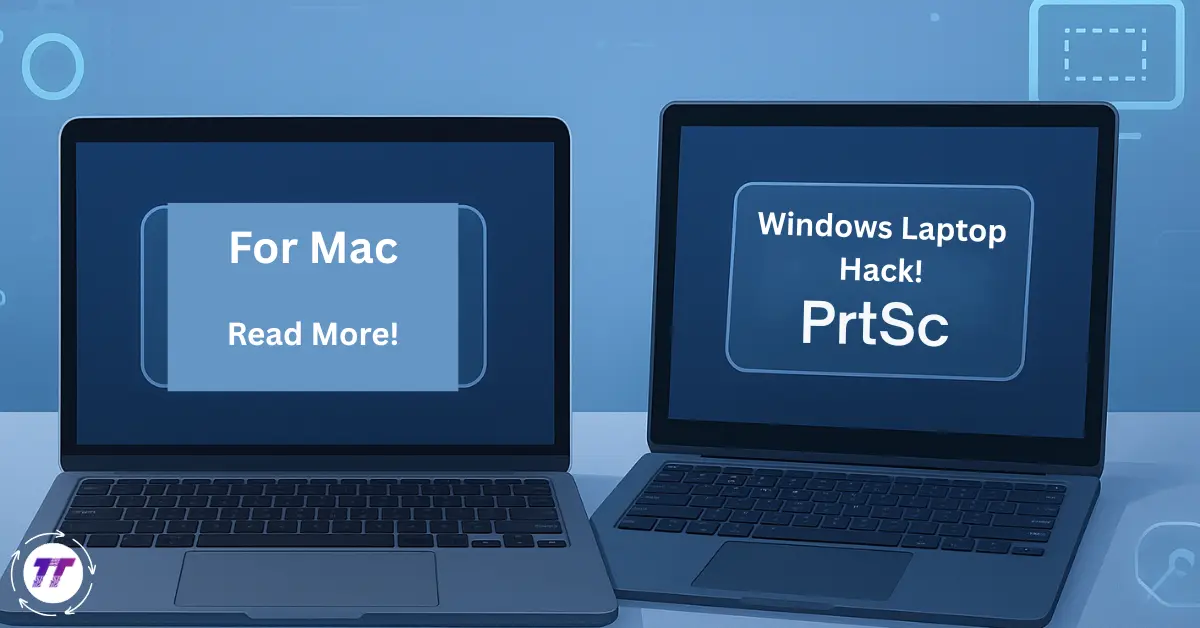Taking a screenshot on Mac and laptop devices may seem confusing at first, but with the right shortcuts and tricks, you can capture your screen in a quick, easy, and reliable way. Whether you’re a student saving notes, a professional documenting work, or someone who simply wants to share what’s on their screen, this guide will walk you through everything you need to know.
📌 Why Screenshots Matter in Daily Life
Screenshots have become a universal tool in both personal and professional spaces. Think about it:
- A student snapping an online lecture slide to revise later.
- A designer saving a quick mockup to share feedback.
- A tech support call where you need to show the exact error message.
Instead of explaining things with long messages, screenshots act as visual proof—they make communication clear, fast, and accurate.
Now, let’s break down how to take screenshots on Mac and Windows laptops, step by step.
🖥️ How to Take a Screenshot on Mac
Mac devices have one of the most versatile and user-friendly screenshot systems built in. No extra apps needed.
✅ Mac Screenshot Shortcuts (Quick Overview)
| Action | Shortcut |
| Capture entire screen | Command (⌘) + Shift + 3 |
| Capture selected portion | Command (⌘) + Shift + 4 |
| Capture a specific window | Command (⌘) + Shift + 4 → Spacebar |
| Open Screenshot Toolbar | Command (⌘) + Shift + 5 |
| Record screen (video) | Command (⌘) + Shift + 5 → Record |
| Copy screenshot to clipboard | Add Control key to any shortcut |
📍 Step-by-Step Guide for Mac
- Entire Screen Capture (⌘ + Shift + 3)
Perfect when you want the full display. The file is automatically saved as a PNG on your desktop.
- Selected Area Capture (⌘ + Shift + 4)
Your cursor changes into a crosshair. Drag to select the part of the screen you want to capture.
- Specific Window Capture (⌘ + Shift + 4, then Spacebar)
Press Spacebar after ⌘ + Shift + 4. Your cursor turns into a camera. Click on the window to capture it.
- Screenshot Toolbar (⌘ + Shift + 5)
This opens the on-screen toolbar with options for:- Capturing full screen
- Capturing a window
- Capturing a selected portion
- Screen recording (video)
- Capturing full screen
- Copy to Clipboard
Add Control key to your shortcut. For example, ⌘ + Control + Shift + 3 will copy the screenshot to the clipboard instead of saving it as a file. You can paste it directly into apps like Word, PowerPoint, or Slack.
🔧 Advanced Mac Screenshot Settings
- Change Default Save Location: By default, screenshots save to Desktop. To change:
- Press ⌘ + Shift + 5 → Options → Save to → choose folder.
- Press ⌘ + Shift + 5 → Options → Save to → choose folder.
- Add a Timer: In the toolbar, you can add a 5- or 10-second delay before the screenshot is taken. Useful when you need time to open menus.
- Markup Tools: After taking a screenshot, a small thumbnail appears at the bottom-right. Click it to annotate, highlight, or crop before saving.
💻 How to Take a Screenshot on Windows Laptops
Windows devices offer multiple ways to capture your screen, from simple shortcuts to advanced tools.
✅ Windows Screenshot Shortcuts (Quick Overview)
| Action | Shortcut |
| Capture entire screen | PrtScn (Print Screen) |
| Copy screen to clipboard | PrtScn + Paste |
| Capture active window | Alt + PrtScn |
| Capture entire screen & save as file | Windows key + PrtScn |
| Open Snipping Tool | Search “Snipping Tool” |
| Open Snip & Sketch / Snipping Tool (new) | Windows + Shift + S |
📍 Step-by-Step Guide for Windows
- Entire Screen Capture (PrtScn)
Press PrtScn to copy the entire screen to the clipboard. Then paste into Paint, Word, or email.
- Active Window Capture (Alt + PrtScn)
Captures only the active window. Handy when you don’t want the entire desktop clutter.
- Auto-Save Screenshot (Windows + PrtScn)
Saves your screenshot directly into Pictures → Screenshots folder.
- Snipping Tool (Classic)
- Search for “Snipping Tool” in the Start Menu.
- Choose Free-form, Rectangular, Window, or Full-screen snip.
- Save, copy, or annotate.
- Search for “Snipping Tool” in the Start Menu.
- Snip & Sketch (Windows 10/11)
- Press Windows + Shift + S.
- Select area to capture.
- Screenshot gets copied to clipboard and opens in editor for annotation.
- Press Windows + Shift + S.
🔧 Advanced Windows Screenshot Tips
- Delay Timer: Snipping Tool and Snip & Sketch allow timed captures (e.g., after 3 or 10 seconds). Perfect for capturing dropdown menus.
- Direct to Clipboard: Use Snip & Sketch if you want to quickly share in apps without saving as a file.
- Third-Party Apps: Tools like Lightshot or Greenshot provide extra features like instant uploads, cloud sharing, and advanced editing.
🆚 Mac vs. Windows Screenshot Comparison
| Feature | Mac | Windows |
| Full Screen Shortcut | ⌘ + Shift + 3 | PrtScn / Windows + PrtScn |
| Custom Selection | ⌘ + Shift + 4 | Windows + Shift + S |
| Save Location | Desktop (default, customizable) | Pictures → Screenshots |
| Built-in Annotation | Yes (Markup) | Yes (Snip & Sketch) |
| Built-in Video Recording | Yes (⌘ + Shift + 5) | Yes (Xbox Game Bar: Windows + G) |
🌍 Real-Life Examples of Screenshot Use
- Work Collaboration: A project manager highlighting changes in a report with a quick screenshot.
- Tech Support: Sending an image of an error code makes troubleshooting faster.
- Online Shopping: Capturing order confirmation before closing the tab.
- Creative Projects: Bloggers, designers, and marketers use screenshots to illustrate tutorials and guides.
Screenshots are more than a tool—they’re a productivity booster.
❓ FAQs on Taking Screenshots
1. How do I take a screenshot on Mac without saving it?
Hold Control with your shortcut. Example: ⌘ + Control + Shift + 3 copies the screenshot to clipboard.
2. Where do screenshots go on Windows?
By default, Windows + PrtScn saves them in the Pictures → Screenshots folder.
3. Can I record my screen without third-party apps?
- On Mac, use ⌘ + Shift + 5.
- On Windows, press Windows + G to open the Xbox Game Bar.
4. Which format are screenshots saved in?
- Mac: PNG by default (can be changed via Terminal).
- Windows: PNG (auto-saved) or depends on the editor you paste into.
5. What’s the best free screenshot tool?
- Mac: Built-in shortcuts are usually enough.
- Windows: Snip & Sketch or Lightshot for advanced use.
✅ Conclusion: Master Screenshots Like a Pro
Learning how to take screenshots on Mac and laptop devices is a small skill with big impact. From capturing online content to troubleshooting, the ability to grab and share your screen instantly saves time, reduces miscommunication, and boosts productivity.
📌 Your Next Step:
Try the shortcuts today on your device. If you often collaborate online, consider using tools like Snip & Sketch (Windows) or the Screenshot Toolbar (Mac) for professional results.
👉 Master this simple trick now, and you’ll never need to explain things the hard way again!


